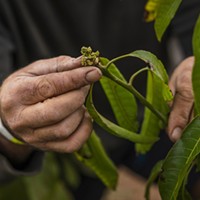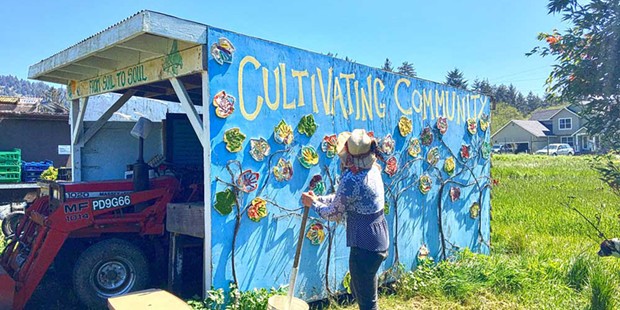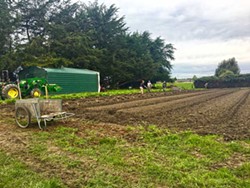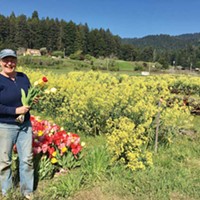'Grab it by the Horns'
Harnessing the environmental, and political, power of our local food system
By Laura B. Johnson[
{
"name": "Top Stories Video Pair",
"insertPoint": "7",
"component": "17087298",
"parentWrapperClass": "fdn-ads-inline-content-block",
"requiredCountToDisplay": "1"
}
]
One of the many things that have been made abundantly clear since Jan. 20: Much-needed shifts toward environmental and community sustainability will not be coming from the top down. Not anytime soon.
In the last three months, the new administration in Washington has taken steps to nix protections for clean air and water, institutionalize climate change denial, deregulate toxic chemicals, decrease animal-welfare transparency, reverse course on clean energy and eliminate programs that support communities and vulnerable populations. And that's just the tip of the iceberg.
For those concerned about the environment, it is more apparent than ever that this country needs to make deep, drastic changes, and fast. But what if, rather than in Congress, this change could start in our daily lives, in our communities, with a collective rethinking of our relationships to the natural world and each other? What if it starts from the ground up, from the grassroots, from the soil?
Literally, the soil.
Whether we think about it or not, we interact with land, plants, animals and other humans every time we sit down for a meal.
"We're an agricultural society, but we're not agrarian anymore," explained Eddie Tanner, owner of DeepSeeded Farm in Arcata and author of The Humboldt Kitchen Gardener, while sitting at a picnic table in one of his greenhouses, taking a break from replanting last season's dahlia tubers. "We've become more urban and suburban, but we're still totally dependent on the products of agriculture, and I think that in many people's daily lives there's not a lot of opportunity to connect with the food that we eat."
When food flows swiftly and abundantly from supermarkets and chain restaurants, produced obscurely in distant places, often processed and packaged beyond recognition, it's easy to lose sight of that connection. But that doesn't mean it's not there.
"The mainstream food system is not sustainable and not healthy in a number of ways," said Debbie Perticara of the North Coast Community Garden Collaborative (NCCGC) and Redwood Community Action Agency. "It depends on fossil fuels for producing, processing and transporting foods that we eat; it depends on cheap labor, often times in adverse work environments, and tends to disadvantage already disadvantaged communities. The health of farmers is also being impacted by the use of chemicals, and arguably the health of our population is being negatively impacted from eating these foods."
That's a lot to process, so let's back up for a minute. What exactly is going on, and how did we get here?
Over the last century, the number of farmers in this country has plummeted to less than 2 percent of the population, a drastic decline from the one-third of all Americans who farmed just 100 years before. But if there are so few farmers, how do we have so much food?
Many of the farms remaining today grew from diverse family-scale farms to bloated industrial ones producing fewer products in much larger quantities, destined not for their communities but for national and global markets driven by fossil fuels. According to a 2011 Food and Agriculture Organization (FAO) of the United Nations report, the food sector accounts for approximately 30 percent of global energy consumption and is responsible for more than 20 percent of greenhouse gas emissions.
Like climate change, this food system is global — industrial, corporate food is simultaneously exported to and imported from other countries, giving our supermarket shelves the impression of limitless bounty, freed from the constraints of geography, seasonality and nature itself. But nature thrives through diversity, not monoculture, and so to grow in this homogenous way farmers rely on chemicals that deteriorate the soil and pollute air, water and even the bodies of human and other living beings.
The goal in this global system is efficiency and profit, producing as much as possible with the least amount of land, labor and care. The labor involved is often performed by the most vulnerable; many undocumented immigrants seek work in American fields or factories, where they often face exploitation, abuse and exposure to toxic chemicals.
Much of the food grown synthetically on these industrial farms isn't even fit for human consumption — it's destined for feedlots that raise livestock in confinement, providing the meat and dairy products that we so eagerly consume. Americans eat more meat than most other countries in the world, according to the FAO, and meat has more of an environmental impact than any other food product.
"In America, most of our beef is grown in feedlots where the cattle are fed mostly corn," said Shail Pec-Crouse recently, amid her evening farm chores feeding animals, moving them to new pastures and collecting goose eggs on Tule Fog Farm in Arcata, which she owns with her husband Sean Armstrong. "And corn is not good for them, it tends to make them sick. So because they're eating almost exclusively corn and they're in a high concentration of animals, they get fed a lot of antibiotics to keep them healthy."
When humans then eat meat from these animals, they also consume these antibiotics, she explained, as well as the pesticide residue from the industrial feed the animals were fed.
"Cattle evolved to eat grass," Pec-Crouse continued. "They do it really well, they're great at converting grass into muscle, and grass-fed beef is lower in saturated fat, it's lower in cholesterol, it's got a better Omega 3-Omega 6 balance, and animals don't require much chemical input because they stay healthier on a grass diet."
Tule Fog Farm raises grass-fed and pastured animals organically for meat, milk and eggs, available through their community supported agriculture (CSA) program. (CSA is a model employed by all the farms featured in this article in which folks agree to financially support farmers over the course of a season in exchange for a weekly share of the farm's bounty.)
Pasture-raised animals significantly reduce the environmental impact of meat products, not to mention the ethical costs of their brutal treatment in the industrial system.
"Growing grains for animal consumption requires a lot of fossil fuels," she said. "The conversion ratio is really low, you have to feed generally three to 10 pounds of corn per pound of meat, whereas grass takes very little tractoring, very little fossil fuels, the animals gather the food themselves, and so there's a lot less climate impact with grass-fed meats."
When buying meat and dairy products in the grocery store, Pec-Crouse encouraged consumers to look for labels like "grass-fed" for beef and "pastured" for pork and poultry products.
"Pastured means they actually get to go outside on the pasture," she said, explaining that labels like "cage free" and "free range" are shallow and mostly meaningless, prone to greenwashing by corporations playing to consumer demand for more sustainably, ethically produced meat, eggs and dairy products.
And for good reason, according to Melanie Cunningham.
"(The vast majority) of the meat consumed in our country is produced in a way that if most people actually had the visceral experiences of being in a chicken factory or a feedlot, they wouldn't support it," said Cunningham, who, along with her husband Kevin, owns Shakefork Community Farm in Carlotta, just beyond the reach of Humboldt's coastal fog.
"We're so distanced from it that we can just go on and eat it and think, 'How bad can it be?' Well, it can be really bad."
The solution to this disconnect from our food and where it comes from is complicated but one of the most meaningful ways people can begin to affect change is to engage with their community food system, even just a little bit. And luckily, we have a vibrant one.
"Our local food system is incredibly strong," said Portia Bramble, executive director of the North Coast Growers Association (NCGA), which operates farmers' markets in Arcata, Eureka, McKinleyville and Willow Creek. "We're much more self-reliant and truly local and self-sustaining than you find almost anywhere else in northern California or the state, and that's really because of the density of farmers that we have such an abundance of local produce."
Farmers like those highlighted in this story are mindful of their impact on the land, prioritizing agro-diversity, symbiotic relationships and care for the plants and animals they cultivate, and the community they feed.
"We're a good example of scaled-up permaculture," said Cunningham of Shakefork Community Farm, which grows coastal veggie staples via regenerative practices, sold at farmers' markets and through their 120-member CSA program. They also raise lamb and chickens for meat and eggs, and plan to sell beef and turkey in the future.
"One of the reasons we have so many livestock is we do a lot of on-farm composting, closing the fertility loop and providing for our own fertility needs with manure produced on the farm," Cunningham said. Many small farmers, even organic ones, purchase fertility amendments from outside sources, often derived from factory farms, she explained. "When you bring in composted chicken manure from a factory farm, you (perpetuate) this ongoing connection with the kind of farming you're trying to get away from."
Back at Tule Fog Farm, Pec-Crouse echoed this sentiment, saying they raise pastured animals, in part, to avoid the necessity of purchasing outside inputs. Her farm also incorporates animals as a food waste diversion project.
"Food waste that goes in the landfill is a really serious climate change factor," she said. "When food decomposes anaerobically, it releases a lot of methane, which is 10 times as bad climate-wise as carbon dioxide."
Her farm has partnered with local restaurants to transfer kitchen scraps to its Kunekune pigs, a small, hairy and friendly breed from New Zealand.
"It's great because it's free food for us, the pigs love it and it keeps the food waste out of the landfills," Pec-Crouse said. She adamantly believes that pork should be America's meat: "We waste so much food in this country and if it all went to pigs instead of in landfills, we could stop growing a lot of corn and we could happily eat bacon and reduce our climate impact all at the same time."
Bayside Park Farm, the city of Arcata's educational farm, similarly emphasizes a closed-loop system and utilizes community partnerships.
"A senior lunch program started composting all their scraps," said farm director Jayme Buckley. "Someone brings it here every week, and they dump it here." She showed off the food waste in the break-down process, which she delightedly called a "delicious slosh of biological activity," and how it transforms into fertile compost that they use to start seedlings, amend fields and top-dress garden beds.
Farms like these are employing practices that meet and, in many cases, exceed U.S. Department of Agriculture's certified organic standards, but many choose not to go through the certification process.
"You can have a conversation with the farmer and find out what their practices are," Bramble explained. "A lot of the folks at the market who are not certified organic are still following the best, most natural practices on their farm while saving a lot of time and cost by not going through the certification process, and they pass on those savings to you."
Unlike large-scale industrial farms producing for national and global markets, small-scale community oriented farms like these remain rooted in place, supporting the local economy, bringing people together to value and support the natural environment and helping communities reimagine ways of being together.
"Supporting local businesses keeps money circulating in the community," said Tanner of DeepSeeded Farm, which produces organic vegetables, berries and fruits for its CSA program. "The money you pay me I pay to employees that in turn shop locally and so, just like supporting any other local business, it helps keep our community thriving."
Beyond economic benefits, eating from your local foodshed can reconnect people to place, seasons and life cycles.
"You're eating everything that's in season, that grows here in the place where we live," explained Buckley of Bayside Park Farm. "So you have to kind of be able to go with that flow, and it really does adjust the way people cook, the way they eat, because you just kind of learn like, 'Oh, maybe you can't eat tomatoes in February,' and this sort of thing."
People shift in other ways, too, when they participate in the farm's intern- and volunteer-run CSA program, she added. "When you're getting this onslaught of the things that are available year-round, like chard, kale and cabbage, you learn to get really familiar with those items because that's just what you've always got. It makes for an adjustment that's really healthy; it benefits your personal health, your community, it's not just an economic decision. It definitely has all these rippling effects."
For Janet Czarnecki, owner of Redwood Roots, a picturesque 10-acre farm in Bayside that grows veggies, flowers, herbs and berries, her farm provides a reconnecting space for her CSA members, volunteers and interns.
"I think the people who come here feel connected — they say it over and over again," she laughed. "The connection to land and being able to see how it changes from week to week, from season to season, and I think in a larger societal way that's missing. People work indoors, we're not physical anymore, people talk about feeling cut off,and so they come here, they talk together, they talk recipes, I greet them, their kids run in the field.
"Belonging to a place, I think that's a yearning most people have."
There are plenty of ways to get involved in the local food system, and no amount of support is too small.
"When you do your small part to support local farmers by shopping at the market or CSA or farm stands or buying local food at the grocery store, you might feel like you're not making a big impact," said Bramble. "But every little bit adds up ... If everyone makes a small change, it has a tremendous impact."
But because the conventional food system drives food prices down by externalizing its cost to the environment, animals and farmworkers, local, sustainably produced food costs more. While this remains a challenge, some innovative programs are at work on the North Coast to make for a more inclusive, accessible food system.
CalFresh electronic benefits transfer (EBT) cards can be used (at least for now) at farmers' markets to help ensure access to healthy foods, and the state's MarketMatch program doubles these benefits, up to $10 per visit. Bramble said these programs have been "tremendously successful," providing farmers with thousands of dollars in additional income and bringing hundreds of new people to local markets each year.
Many local farms also accept EBT on-farm, supplementing the creative methods they've developed to ensure access to their products. Czarnecki, for example, accepts EBT payments for CSA shares, in addition to offering sliding scale and flexible payment plans.
"If finances are an issue, I don't want anybody to stress," she said.
Redwood Roots, like many other farms, also donates produce to Food for People, and on-farm volunteers and interns exchange time and labor for experience, education and some food to take home.
Community gardens are also a crucial component of ensuring access to affordable, healthy food for community members, said Perticara of the NCCGC, which fosters a supportive network of community gardens and gardeners on the North Coast. While the gardens come in many shapes and structures, she said they all provide people with an affordable space — the average annual cost of a plot is roughly $25 — to grow food.
"For the cost of a pack of seeds, $3 or so, an abundance of food can be grown," she said, adding that CalFresh benefits can also be used to purchase seed and plant starts.
In addition, growing in a community garden provides opportunity for physical activity, relationships and community revitalization.
"It gets you outside," Perticara said. "A lot of people find gardening to be not only relaxing but therapeutic, and they note that it's a chance to have positive social interactions ... providing cross-cultural and intergenerational learning opportunities. (Gardens) can beautify neighborhoods, add to a sense of trust as people get to know each other, and it becomes a focal point of the community ... creating a sense of place and connectedness with one another."
Stepping back, it's clear that the state of our local food system is strong and each of the farmers interviewed for this story expressed gratitude for the support they receive.
"I feel grateful to be in a community that really supports local food production," said Tanner of DeepSeeded Farm as he eyed the field — the sky told of impending rain and he needed to get back out there. "A lot of people locally have clued into the fact that it's great, that the food tastes better, you get it fresher, you can find great deals, and it's kind of a win-win."
Yet there's more work to be done. Despite strong community support, farmers still struggle due to the aforementioned structure of the industrial food system.
"It's extremely hard to make money farming," said Pec-Crouse. Cunningham of Shakefork Community Farm agreed, adding that a truly sustainable food system has to factor both farmers' and farmworkers' livelihoods into the equation.
"We work really hard, yet we don't have health insurance, retirement plans, it's hard to pay our farmworkers what they deserve," she said. "How do we measure success? Do our workers have insurance? Can we provide livable wages for our employees? That's room for growth that I still see, and I don't know how to get there exactly, but hopefully we will as a community."
Still more consumer awareness is needed. In order to purchase and make good use of local food, people need to know how to prepare and preserve it. "You can save a lot of money by properly cleaning and preserving your produce," Bramble said. "Freezing, making meals in advance, canning, pickling, fermenting, all are wonderful ways to eat and to save produce for when it's out of season."
The prevalence of cannabis growing is also important to consider, said Cunningham, citing the recent decision to allow cannabis cultivation on prime agricultural land, an allocation of resources that does not support the goal of a flourishing local food economy.
"Because people can make more money doing other types of farming, they can get kind of lazy," she said. "They don't push to grow year-round because they don't have to. ... We struggle with labor because we can't pay people the wages that the cannabis industry can, so it's an ongoing struggle in this region. ... There's so much buzz around the cannabis industry, and I'm just like, 'Why can't people get so excited about food?'"
Despite being one of the state's most self-reliant communities, it seems the depths of our potential remains untapped. "We still have a lot of room for growth here," Bramble said. "There's more demand than we're able to make across the board, and growing year-round is not as common here as it could be. ... There's room for more production."
This points to unique opportunities for new, young farmers (a hopeful trend in some places across the country), and there's plenty of opportunity to learn through on-farm internships, volunteer opportunities, workshops and classes of all kinds. Buckley of Bayside Park Farm noted that she's witnessed an outpouring of interest since the November election.
"There's been this surge of people looking for ways to become engaged in the community and with each other," she said brightly. "A lot of people I've talked to since then are wanting a way to become more active and it feels like it's motivated by this sense that, if we don't grab it by the horns, it's gonna' run us over.
"It's really just taking that power back. Food is one of our basic essential needs and one of our basic joys. It's something people can agree on. ... And that's just so powerful in itself."
Laura Johnson is a cultural geographer and a multi-disciplinary lecturer at HSU. She is passionate about community food systems and thinks the Arcata Farmers' Market is one of the most joyful places on earth.
Speaking of...
-

Mangoes and Agave in the Central Valley? California Farmers Try New Crops to Cope with Climate Change
May 10, 2023 -

Jump-Starting Electric Car Batteries: Will Supply Problems Stall California’s Mandate?
Mar 1, 2023 -

Can California’s Power Grid Handle a 15-fold Increase in Electric Cars?
Jan 17, 2023 - More »
Latest in News
Readers also liked…
-
Through Mark Larson's Lens
A local photographer's favorite images of 2022 in Humboldt
- Jan 5, 2023
-
'To Celebrate Our Sovereignty'
Yurok Tribe to host gathering honoring 'ultimate river warrior' on the anniversary of the U.S. Supreme Court ruling that changed everything
- Jun 8, 2023


































